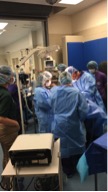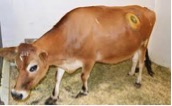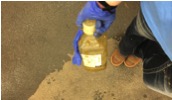I can’t believe it’s over! Today was my last day and it was a pretty emotional one. I am ready to get back home, but I am going to miss this amazing experience and all the people I have met here. My last day consisted of getting to participate in some really cool activities, and then suddenly being hit with the sadness that comes with having to leave. Needless to say, there were a few tears shed… Don’t worry, they were in the privacy of my truck after I left (yes, even the toughest of us shed tears occasionally) but all I’ve known for six weeks is this school and these people and leaving is bittersweet.
Now that the emotions are out of the way, let’s talk about my amazing week. Where do I even begin? I witnessed two rumen donor cows, two sick calves, three surgeries, four goats, four births, (five golden rings…), seven bulls, and about twelve alpaca this week.Every encounter brought something new and interesting to the table. I have also found that my suture skills are pretty admirable, especially considering it was my first time trying one of the most difficult suture styles to learn. This week has been full, but I could not have even wished for a better final week to my internship.
So, I mentioned briefly the things I witnessed this week, and I should probably explain them further. The KSU VHC keeps animals that they call “teaching herds”. These animals are used for study, teaching procedures to vet students, and as donors: usually blood, but in the case of ruminant animals (cattle, goats, etc.) they also donate rumen fluid. KSU has two donor cattle that live in a pen across the parking lot from the vet school. These cattle are unique in the sense that they have plastic caps in their sides that open and give access to the rumen fluid, which is contained in the cow’s stomach chambers. This fluid (awful smelling and greenish in color) is used to digest the plant material that cattle consume. It can be transplanted between the healthy donor cows and other ruminant animals to relieve bloat, keep a stable pH balance, and promote helpful bacteria levels in ruminant animals that have indigestion and related issues.
I ran into the food animal vet tech returning from lunch on Monday and she asked me if I would help her with something. As she intimidates me, and also wanting to be hands-on in any way possible, I didn’t dare say no. I was promptly handed an empty bottle and a pair of gloves and taken across the parking lot to the donor pen. Wondering what I had gotten myself into, I asked what the plan was. The tech told me that while I was gone for lunch a goat came in struggling with a rumen imbalance and that we were going to give the goat a transfaunation (giving the sick goat healthy rumen fluid by way of esophageal tube). I put on the gloves, and we spent the next fifteen minutes transferring fluid from an open hole in a cow’s side into a very skinny-topped bottle. I smelled like rumen fluid for the rest of the day. It is a haunting, exceptionally strong smell that turned heads when walking into a room, and took a very long shower to get rid of. I’m happy to say, our little goat is okay.
Over the course of the week, I was also able to be a part of two umbilical hernia surgeries, and a mastectomy on a goat. I also got to witness the miracle of life… or somewhat. The only downside to this career is that we see a lot of death and sickness, but the animals we save make it all worth it. We were, however, able to diagnose and save two of the sick calves that came in.
Along with rumen donor cows, KSU also has a herd of alpaca, which I got to meet later in the week. We had an alpaca come in with an inner ear infection due to parasites. The infection was causing him to have neurologic symptoms, and to be ataxic. Because the parasites caused a loss of blood, he needed a blood transfusion. Alpaca are extremely social animals and need to be around other alpaca so the sick alpaca brought a healthy friend to keep him company.
I came back from a surgery to a lot of commotion coming from the area where we were keeping the alpaca and his friend. To my surprise, there were no longer two alpaca, but twelve. Apparently the donor herd is inseparable, so instead of only bringing in one alpaca to draw blood, they had to bring the whole herd. Alpaca tend to make strange, almost human ranges of noises. I’m also pretty sure the phrase “copy cat” should be changed for them because, apparently, what one herd member does, they all must do. After drawing the blood from the donor alpaca, the vet students put me in charge of the blood bag. I walked around for about an hour oscillating the blood so that it wouldn’t clot in the bag while they did a spinal tap on the patient; so technically, I saved an alpaca’s life because without that blood, he wouldn’t have gotten much better.
This internship has been one of the most amazing experiences of my life. I would like to say thanks so much again to Pinhead Institute, and everyone at the Kansas State University Veterinary Health Center, and School of Veterinary Medicine for this once in a lifetime opportunity. Thank you for helping me find where I belong, and teaching me so much!





There are no comments published yet.